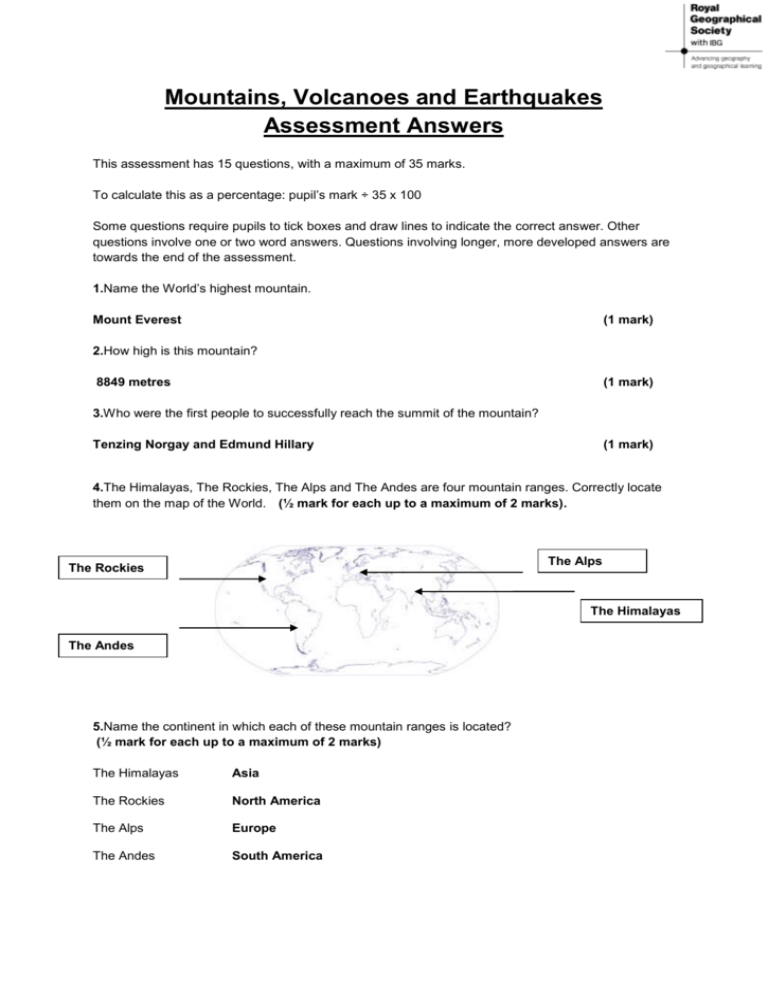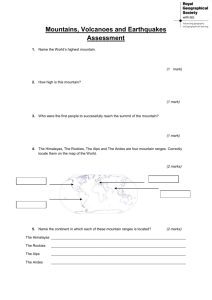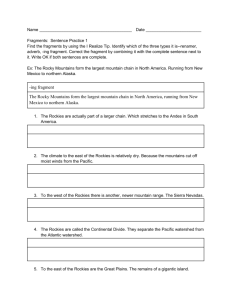Mountains, Volcanoes and Earthquakes Assessment Answers This
advertisement

Mountains, Volcanoes and Earthquakes Assessment Answers This assessment has 15 questions, with a maximum of 35 marks. To calculate this as a percentage: pupil’s mark ÷ 35 x 100 Some questions require pupils to tick boxes and draw lines to indicate the correct answer. Other questions involve one or two word answers. Questions involving longer, more developed answers are towards the end of the assessment. 1.Name the World’s highest mountain. Mount Everest (1 mark) 2.How high is this mountain? 8849 metres (1 mark) 3.Who were the first people to successfully reach the summit of the mountain? Tenzing Norgay and Edmund Hillary (1 mark) 4.The Himalayas, The Rockies, The Alps and The Andes are four mountain ranges. Correctly locate them on the map of the World. (½ mark for each up to a maximum of 2 marks). The Alps The Rockies The Himalayas The Andes 5.Name the continent in which each of these mountain ranges is located? (½ mark for each up to a maximum of 2 marks) The Himalayas Asia The Rockies North America The Alps Europe The Andes South America 6.The following diagram shows a cross section of a volcano. Label the features indicated by the arrows. (1 mark for each up to a maximum of 4 marks) Ash or pyroclastic flow Pipe or conduit Sill Magma chamber 7.Use arrows to join the names of the four highest peaks in the UK to their loyalties. (½ mark for each up to a maximum of 2 marks) Ben Nevis England Snowdon Northern Ireland Scarfell Pike Wales Slieve Donard Scotland 8.Which of the four peaks is the UK’s highest? Ben Nevis (1 mark) 9.How high is this peak? 1344 metres (1 mark) 10.These diagrams show three types of mountain formation. Name each type. A Fault Block (1 mark) B Dome (1 mark) C Fold (1 mark) 11.Where would you see these mountain formations in the World? Give a real-life example of a mountain, or mountain range, for each formation shown. Formation A The Sierra Nevada range (USA) (1 mark) Formation B Either The Black Hills mountain range or Mount Rushmore (1 mark) Formation C Any of the following: The Himalayas, The Andes, The Rockies, The Alps (1 mark) 12a.Some people live near volcanoes. Give four advantages that volcanoes bring to an area. 12b.Give specific real-world examples where you can. Pupils’ answers should include the following information: Advantages: Geothermal energy, tourism, fertile soils for agriculture, minerals (for example sulphur mining or diamond mining). (1 mark for each up to a maximum of 4 marks). Real-world examples may include the following (1 mark for each up to a maximum of 4 marks). Geothermal energy in Iceland Tourism in Hawaii (North America) OR Old faithful in Yellowstone (North America) Fertile soils Vineyards in the foothills of Mount Etna, Sicily, Italy OR tomato growing in the foothills of Mount Vesuvius, Italy Sulphur mining in East Java OR diamond mining in Russia 13.What are the disadvantages of living near a volcano? (1 mark for each up to a maximum of 3 marks). Volcanic eruptions/lava flows Volcanic ash and gases that can be poisonous Lahars or mudflows Unpredictable 14.The power of earthquakes is measured on the Richter scale. Tick the box next to the earthquake that is more powerful. (1 mark) An earthquake with a magnitude of 3 on the Richter scale OR An earthquake with a magnitude of 7 on the Richter scale √ 15.Describe the possible effects of an earthquake with a magnitude of 7 on the Richter scale. Any two of the following (1 mark for each up to a maximum of 2 marks). Serious damage- walls crack and split The majority of buildings collapse Bridges twist Loss of life






